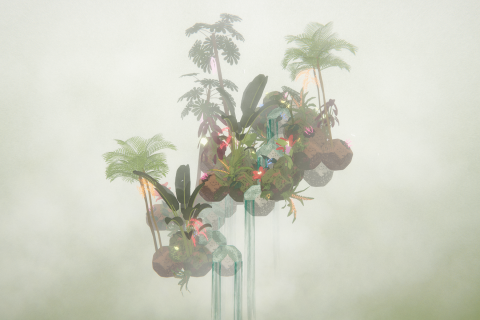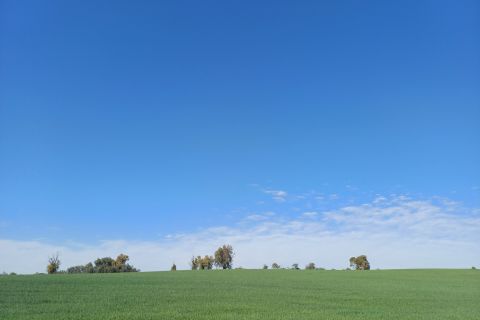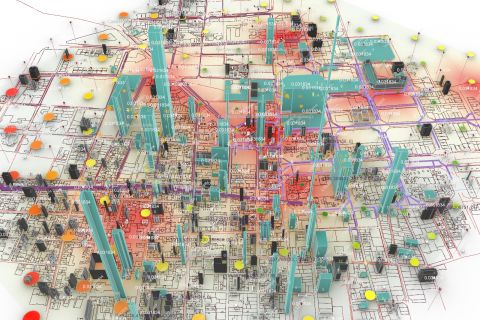Bezalel News
חדשות בצלאל
أخبار بتسلئيل
Tailplane- Between the Hegemonic and the Subversive: between Commemoration and Protest, and so forth
Our symbols can be shattered,
But not our spirits
Our banners can be trampled,
But not our values
Our statues can be broken,
But not our hope
This text welcomes visitors to the Tel Aviv Museum and Beit Ariella since early April 2023. Not far from it stands an artwork by Amir Yatziv made up of two elements: pieces of grey-colored broken wood of varying sizes, and an upright fist made of a black painted wooden net. In the center of this piece, shines a blue star on a white circular background. It is, of course, the symbol of the Israeli Air Force.
This is, in fact, the second phase in the life of this artwork. Previously it was a statue of an F-16 tailplane, that appeared as if it had crashed to the ground after being hit for some unknown reason. On the tip of its tail was a large engraved fist. The statue was placed here by a group of former Air Force fighters as part of the protest against the Judicial Reform. But the statue, meant to symbolize the collapse of democracy was itself crushed by right-wing demonstrators, supporters of the Judicial Reform, only several days after it was placed in front of the museum.
I would like to express some thoughts that come up at the sight of this artwork, in both its forms. Although on the surface, there’s no solid connection between the two statues, comparing them nonetheless provides an overall image of what has been happening here in the past months, something which should be seen in different cultural, physical-spatial and historic contexts.
Thought #1: Combining symbols- the ABC of visual semiotics
While the protest continues and the confrontation has yet to be decided, it becomes clear that a fascinating visual language is being formed, a language that includes a variety of symbols spreading over different kinds of media and appearing in artistic designs. We see it with the fist, the flag, the color red in general, in the ‘Handmaid’s March’ in particular, and in the endless banners and installations that weave words with images in wonderfully creative ways. In light of which it is interesting to see the combination of the fist, that became the ultimate symbol of the protest, with the remains of the tail of the plane. They speak in different languages of design but appear together in this single artwork.
Thought #2: the urban space- enclosed by public structures, and a platform for outdoor sculpture
The location chosen for the work, isn’t just any place (as if there is such a thing as ‘any place’). We’re speaking of a central urban plaza, that is the entry to Tel Aviv’s most important and largest art museum and second, to a public library. The third constructed edifice is the back side of the courthouse. From the other side of the street you can see the "Kirya” complex. Art and culture, law and security, join together to become the enclosure, and a platform for a group of artworks. The most important and memorable of them is probably Menashe Kadishman’s “Akedat Yitzhak” (the Binding of Isaac, 1982-1985) that weaves the biblical myth with the Israeli ethos. We must also take into account that this plaza was used for countless demonstrations and protests since the official launching of the museum in 1971. As such, it joins Rabin Square (previously known as Kings of Israel Square) and Habima Square as the main locations for demonstrations in the city.
Thought #3: The destruction of artworks – from the hegemonic-institutionalized to the subversive and vice versa
History is replete with incidents where statues of leaders or images representing the government were destroyed by those opposed to the regime or those who sought to challenge the hegemonic narrative. In this context, suffice it to mention the statues of Lenin, Stalin, Saddam Hussein and the leaders of the Confederate Army in the American Civil War, that were defaced, dismembered, knocked-over and removed as acts of resistance and revenge, and which by their nature were subversive and anti-establishment actions. Supposedly, this is what happened to the Tailplane. Only in this case it’s the exact opposite: even if it wasn’t government representatives or their official delegates who destroyed the work, it was still done by supporters of the government and particularly its leader. They were the ones ruining the subversive artwork, while at the same time documenting themselves shouting the name of their leader and landlord.
Thought #4: Israel 2023, between commemoration and protest, and so forth
At the sight of the Tailplane, it is impossible not to think about different monuments all over the country commemorating those who died in different Israel wars. In the crowded field of local monuments, one distinguishable group of works is based on "remnants from battles", from guns and cannons to tanks and armored personnel carriers. These were either placed as spontaneous monuments by the warriors themselves after the fighting, or were later incorporated into an official statue or monument. The common denominator of the monuments is that they’re mostly located in the battlefield itself, as eternal testimony to what happened there, the fighter’s bravery and duty to the cause, to the country and to its people. Obviously, the first monument that comes to mind are the chassis of the armored vehicles on the side of the road, on the climb to Jerusalem. But the place of airplanes or parts of them, is also well known. Such is, for instance, the monument in memory of Avshalom (Avsha) Rom (Friedman) and Avihu Ikar, a pilot and a navigator, who died together in a training flight in 1977. The monument at Ahihud Junction in the Galilee was constructed in 1979 and includes the rear of the Phantom plane that crashed to the ground.
The location of this work in the heart of a plaza, which as previously mentioned hosted many demonstrations and protests, may be reminiscent of the monuments placed in the battle fields that became a part of the "heritage of battle" narrative. As for the statue embedding the tailplane leftovers with the fist, indeed reminds one of the monuments that combine the remains of weapons into a sculptural work. As in many of Igal Tumarkin's monuments, for example “The Valley Memorial” in the Jordan valley (1972).
Returning to the text we began with, the "symbol, the banner and the statue", are here, as well as "spirit, values and hope". And they are woven together in many layers: the urban court, the streets where the demonstrations are held, and the numerous memorial sites for those who died in the battles of the land of Israel. These elements feed each other.
Yet a further chapter: just before this text was published on the website, the artwork was sprayed with graffiti saying: “The Nazi Rabin” with a swastika next to it. Another chapter in vandalism. Another component in the blend of the "Israeli", in its history and its present.
Dr. Naomi Meiri-Dan
Lecturer in the Department of Visual and Material Culture











